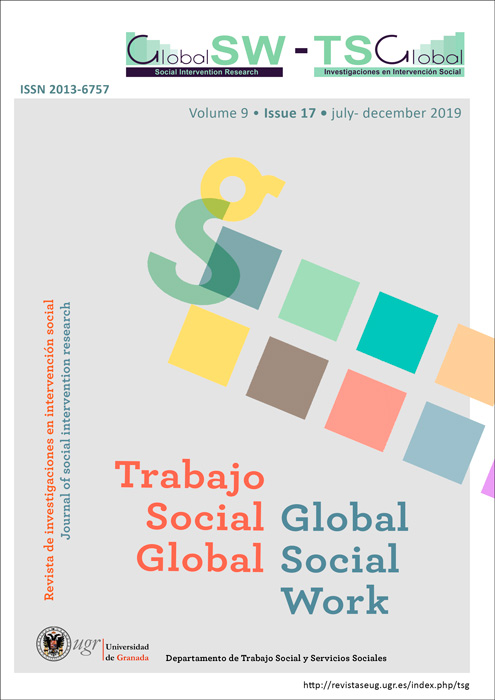Prevalence and risk factors associated with burnout syndrome among social work professionals in municipal social services in Spain
DOI:
https://doi.org/10.30827/tsg-gsw.v9i17.8284Keywords:
social workers, social services, burnout, health, risk factorsAbstract
The international scientific literature has shown a high prevalence of burnout among Social Work professionals. The aim of current research is to determine the prevalence of burnout, as well as the associated demographic factors among Social Work professionals who work in the Social Services System. A cross-sectional analytical study was carried out on a total of 77 members of the Professional Colleges of Social Work in Seville and Murcia. Using a questionnaire previously validated, administered online, information was collected about the demographic, occupational and prevalence characteristics of burnout (through the dimensions of emotional exhaustion, depersonalization and personal accomplishment). A high degree of burnout was found with a general prevalence of 37.6%. In the same way, the different dimensions analysed as emotional fatigue (41.4%), depersonalization (58.2%) and low personal accomplishment (19.6%) are common among the participants. Among the statistically significant variables stand out (p ≤ 0.001) the age, the number of children and the time spent in the profession. The professional training and supervision might contribute to improve the personal and work conditions of the Social Workers and the quality of the service providers.
Downloads
References
Abdallah, T. (2009). Prevalence and predictors of burnout among Palestinian social workers. International Social Work, 52(2), 223–233. doi: 10.1177/0020872808099732
Acker, G. M. (1999). The impact of clients' mental illness on social workers' job satisfaction and burnout. Health & Social Work, 24(2), 112-119. doi: 10.1093/hsw/24.2.112
Alarcón, G., Eschleman, K. J. & Bowling, N. A. (2009). Relationships between personality variables and burnout: a meta-analysis. Work & Stress, 23(3), 244-263.
Albino, L. P., Agüero, E. R., Martínez, L. S. y Vega, E. D. (2002). Burnout en médicos de atención primaria de la provincia de Cáceres. Atención Primaria, 29(5), 294-302. doi: https://doi.org/10.1016/S0212-6567(02)70567-2
Asociación Médica Mundial (2008). Declaración de Helsinki de la Asociación Médica Mundial. Principios éticos para las investigaciones médicas en seres humanos. Madrid: Colegios Oficiales de Médicos.
Awa, W. L., Plaumann, M. & Walter, U. (2010). Burnout prevention: a review of intervention programs. Patient Education and Counseling, 78(2), 184-190. doi: 10.1016/j.pec.2009.04.008
Bakker, A. B. & Demerouti, E. (2007). The job demands-resources model: State of the art. Journal of Managerial Psychology, 22(3), 309-328. doi:10.1108/02683940710733115
Barrera, E. B., Malagón, J. L. y Sarasola, J. L. (2015). Trabajo Social, su contexto profesional y el Síndrome de Burnout. Comunitania. Revista Internacional de Trabajo Social y Ciencias Sociales, 9, 51-71. doi: https://doi.org/10.5944/comunitania.9.2
Ben-Porat, A. & Itzhaky, H. (2015). Burnout among trauma social workers: The contribution of personal and environmental resources. Journal of Social Work, 15(6), 606-620. doi: https://doi.org/10.1177/1468017314552158
Boluarte, A. (2014). Propiedades psicométricas de la Escala de satisfacción laboral de Warr, Cook y Wall, versión en español. Revista Médica Herediana, 25(2), 80-84.
Burke, R. J. (1987). Burnout in police work an examination of the Cherniss model. Group & Organization Management, 12(2), 174-188.
Caravaca Sánchez, F., Carrión Tudela, J. y Pastor Seller, E. (2018). Síndrome de burnout y satisfacción laboral en profesionales del trabajo social en prisiones de España. Revista Española de Sanidad Penitenciaria, 20(2), 40-46.
Center for Workforce Studies, NASW. (2006). Licensed Social Workers in the U.S., 2004. URL: http://workforce.socialworkers.org/studies/intro.pdf.
Crowder, R. & Sears, A. (2017). Building resilience in social workers: an exploratory study on the impacts of a mindfulness-based intervention. Australian Social Work, 70 (1), 7-29. doi: https://doi.org/10.1080/0312407X.2016.1203965
Cuevas de las, C. (1994). El desgaste profesional en atención primaria: presencia y distribución del síndrome de burnout. Madrid: Laboratorios Servier.
Dollard, M. F., Winefield, H. R., Winefield, A. H. & De Jonge, J. (2000). Psychosocial job strain and productivity in human service workers: a test of the demand‐control‐support model. Journal of Occupational and Organizational Psychology, 73(4), 501-510. doi: https://doi.org/10.1348/096317900167182
Esteban-Ramiro, B. y Fernández-Montaño, P. (2017). Las competencias para el desempeño profesional en Trabajo Social dentro de la formación: del burnout al engagement a través del manejo de las emociones. Trabajo Social Global – Global Social Work, 7(13), 142-168. URI: http://hdl.handle.net/10481/48814
Evans, S., Huxley, P., Gately, C., Webber, M., Mears, A., Pajak, S. et al. (2006). Mental health, burnout and job satisfaction among mental health social workers in England and Wales. The British Journal of Psychiatry, 188(1), 75-80. doi: 10.1192/bjp.188.1.75
Facal-Fondo, T. (2012). Prevalencia del Síndrome de Burnout en trabajadores sociales de los servicios sociales comunitarios. Portularia, 12(1), 59-69.
Freudenberger, H. J. (1974). Staff burn‐out. Journal of Social Issues, 30(1), 159-165.
Gilbar, O. (1998). Relationship between burnout and sense of coherence in health social workers. Social Work in Health Care, 26(3), 39-49. doi: 10.1300/J010v26n03_03
Gillespie, D. F. (Ed.) (2013). Burnout among social workers. New York and London: Routledge.
Gil-Monte, P. y Moreno Jiménez B. (2007). El síndrome de quemarse por el trabajo (burnout) (1ª ed.). Madrid: Pirámide.
Giménez, V. M. (2000). El fenómeno del Burnout en las profesiones de ayuda. Estudio experimental de la situación en centros sociales municipales de la ciudad de Alicante. Revista de Trabajo Social, 159, 65-102.
Gosling, S. D., Vazire, S., Srivastava, S. & John, O. P. (2004). Should we trust web-based studies? A comparative analysis of six preconceptions about internet questionnaires. American Psychologist, 59(2), 93-104. doi: 10.1037/0003-066X.59.2.93
Henry, D., Chertok, F., Keys, C. & Jegerski, J. (1991). Organizational and family systems factors in stress among ministers. American Journal of Community Psychology, 19(6), 931-952.
Hombrados-Mendieta, I. & Cosano-Rivas, F. (2013). Burnout, workplace support, job satisfaction and life satisfaction among social workers in Spain: A structural equation model. International Social Work, 56(2), 228-246. doi: https://doi.org/10.1177/0020872811421620
Horton, J. J., Rand, D. G. & Zeckhauser, R. J. (2011). The online laboratory: Conducting experiments in a real labor market. Experimental Economics, 14(3), 399-425. doi: https://doi.org/10.1007/s10683-011-9273-9
Hussein, S., Manthorpe, J., Ridley, J., Austerberry, H., Farrelly, N., Larkins, C., et al. (2014). Independent children’s social work practice pilots: Evaluating practitioners’ job control and burnout. Research on Social Work Practice, 24(2), 224-234. doi: 10.1177/1049731513492859
Kim, H. & Lee, S. Y. (2009). Supervisory communication, burnout, and turnover intention among social workers in health care settings. Social Work in Health Care, 48(4), 364-385. doi: 10.1080/00981380802598499
Kim, H. & Stoner, M. (2008). Burnout and turnover intention among social workers: Effects of role stress, job autonomy and social support. Administration in Social Work, 32(3), 5-25. doi:https://doi.org/10.1080/03643100801922357
Kim, H., Ji, J. & Kao, D. (2011). Burnout and physical health among social workers: a three-year longitudinal study. Social Work, 56(3), 258-268. doi: https://doi.org/10.1093/sw/56.3.258
Koeske, G. F. & Koeske, R. D. (1989). Work load and burnout: Can social support and perceived accomplishment help? Social Work, 34(3), 243-248.
Lázaro Fernández, S. (2004). El desgaste profesional (síndrome de burnout) en los trabajadores sociales. Portularia: Revista De Trabajo Social, 4, 499-506. URI: http://hdl.handle.net/10272/191
Leiter, M. P. y Maslach, C. (2008). Early predictors of job burnout and engagement. Journal of Applied Psychology, 93(3), 498-512. doi: 10.1037/0021-9010.93.3.498
Lima, A. I. (2016). II Informe sobre los Servicios Sociales en España (ISSE). Madrid: Consejo General del Trabajo Social. URL:
https://www.cgtrabajosocial.es/files/5a9ea2319617d/II_ISSE_DIGITAL_2016.pdf
Lloyd, C., King, R. & Chenoweth, L. (2002). Social work, stress and burnout: A review. Journal of Mental Health, 11(3), 255-265. doi: 10.1080/09638230020023642
Martín, A. B. B., Martínez, Á. M., Cardila, F., Jurado, M. D. M. M., del Carmen Pérez-Fuentes, M. y Linares, J. J. G. (2015). Variables relacionadas y prevalencia del burnout en profesionales sanitarios. European Journal of Health Research, 1(1), 5-14. doi: 10.1989/ejhr.v1i1.1
Maslach, C. (1986). Understanding burnout: definitional 1. issues in analyzing a complex phenomenon. En W. S. Paine (ed.), Job Stress and Burnout. Beverly Hills: Sage Publications.
Maslach, C. Jackson, S. E. & Leiter, M. (1981). Maslach Burnout Inventory: MBI. Palo Alto, California: Consulting Psychologists Press.
Maslach, C. & Leiter, M. P. (1997). The truth about burnout. San Francisco: Jossey-Bass.
Maslach, C., Schaufeli, W. B. & Leiter, M. P. (2001). Job burnout. Annual Review of Psychology, 52(1), 397-422.
Máximo Molina Linde, J., Ávalos Martínez, F. y Giménez Cervantes, I. (2005). Burnout en enfermería de atención hospitalaria. Enfermeria Clinica, 15(5), 275-282. doi: 10.1016/S1130-8621(05)71127-X
Padyab, M., Richter, J., Nygren, L. & Ghazinour, M. (2013). Burnout among social workers in Iran: Relations to individual characteristics and client violence. Global Journal of Health Science, 5(4), 142-150. doi:10.5539/gjhs.v5n4p142
Pastor, E., Verde, C. & Lima, A.I. (2019). Impact of neo-liberalism in Spain: research from social work in relation to the public system of social services. European Journal Social Work, 22(2), 277-288. doi: https://doi.org/10.1080/13691457.2018.1529663
Seiderman, S. (1978). Combatting staff burn-out. Early Childhood Education Journal, 5(4), 6-9.
Shinan-Altman, S., Werner, P. & Cohen, M. (2016). The connection between illness representations of Alzheimer's disease and burnout among social workers and nurses in nursing homes and hospitals: a mixed-methods investigation. Aging & Mental Health, 20(4), 352-361. doi: 10.1080/13607863.2015.1008983
Siebert, D. C. (2006). Personal and occupational factors in burnout among practicing social workers: Implications for researchers, practitioners, and managers. Journal of Social Service Research, 32(2), 25-44. doi: https://doi.org/10.1300/J079v32n02_02
Soto-Rosales, A. y González-Losada, S. (2018). Satisfacción laboral y desgaste profesional en trabajadores de servicios sociales de atención a la infancia. Trabajo Social Global – Global Social Work, 8(14), 80-107. doi: https://dx.doi.org/10.30827/tsg-gsw.v8i14.7222
Storlie, F. J. (1979). Burnout: the elaboration of a concept. The American Journal of Nursing, 79(12), 2108-2111.
Tartakovsky, E. & Walsh, S. D. (2016). Burnout among social workers working with immigrants from the former Soviet Union and Ethiopia in Israel: Testing the connections between personal value preferences, immigrant appraisal and burnout. International Journal of Intercultural Relations, 53, 39-53. doi: 10.1016/j.ijintrel.2016.04.002
Travis, D., Lizano, E. & Mor-Barak, M. (2016). “I”m so stressed!’: a longitudinal model of stress, burnout and engagement among social workers in child welfare settings. The British Journal of Social Work, 46(4), 1076–1095. doi: https://doi.org/10.1093/bjsw/bct205
Wagaman, M. A., Geiger, J. M., Shockley, C. & Segal, E. A. (2015). The role of empathy in burnout, compassion satisfaction, and secondary traumatic stress among social workers. Social Work, 60(3), 201-209. doi: https://doi.org/10.1093/sw/swv014
Warr, P., Cook, J. & Wall, T. (1979). Scales for the measurement of some work attitudes and aspects of psychological well‐being. Journal of Occupational Psychology, 52(2), 129-148.
Winstanley, S. & Hales, L. (2014). A preliminary study of burnout in residential social workers experiencing workplace aggression: Might it be cyclical? British Journal of Social Work, 45(1), 24-33. doi: 10.1093/bjsw/bcu036
Downloads
Published
How to Cite
Issue
Section
License
Authors publishing in this journal agree to the following terms:
- Authors retain their copyright. They guarantee to this journal the right to a first publication of the work submitted to initiate the editorial process.
- Authors know that their work is published under a Creative Commons License which allows others to share it, with a recognition of the work's authorship and its initial publication in this journal.
- Authors share with Global Social Work explotation rights of the work that has been published in this journal, authorizing the execution of a free reproduction, distribution and public communication. Authors know that their work will be stored on servers and reproduced in digital format for inclusion in institutional repositories and databases that will facilitates free access to the full text of the work.
- Authors may distribute the version of the work published in this journal (for example, to an institutional repository or publish it in a book), with the explicit acknowledgment of its initial publication in this journal.
Copyright on the texts published in Trabajo Social Global -Global Social Work, as well as editorial policy of the journal refering to self-file and deposit in institutional or thematic repositories, are identified in the database





















